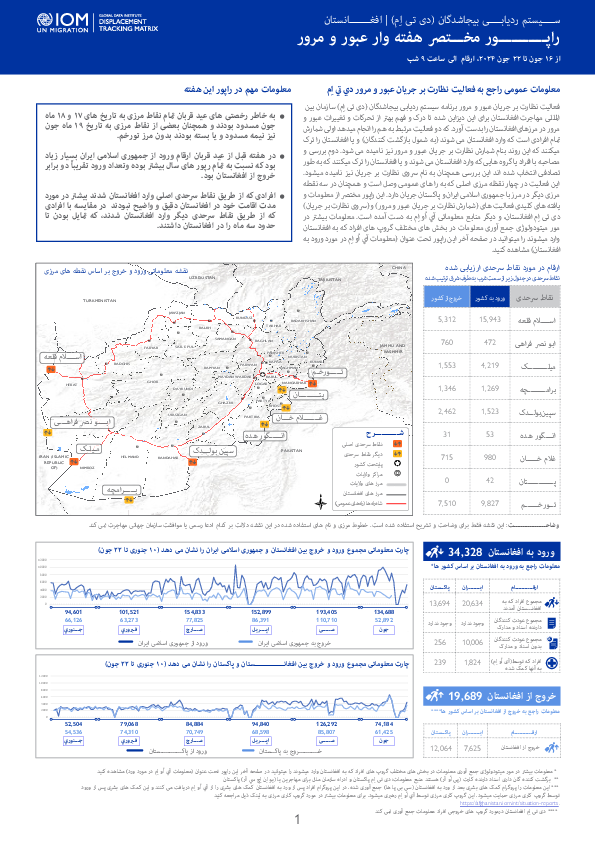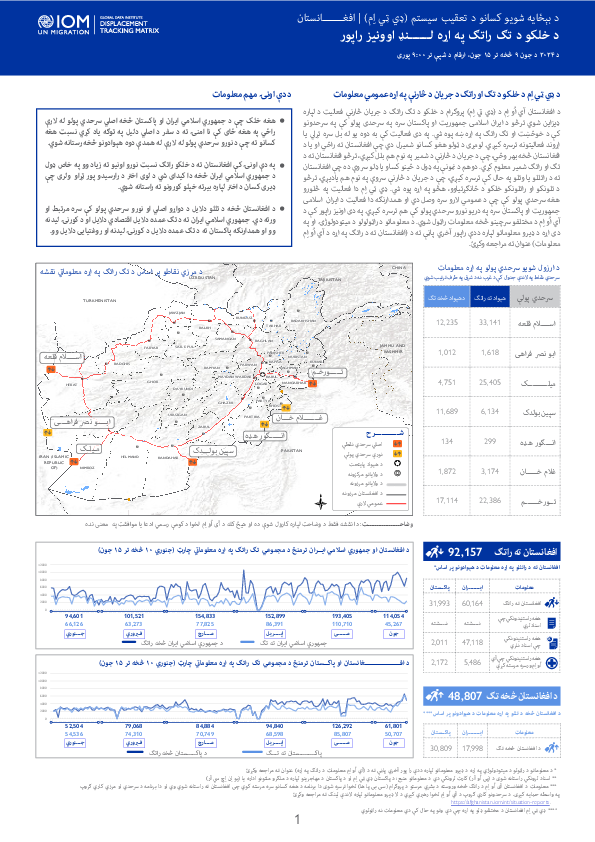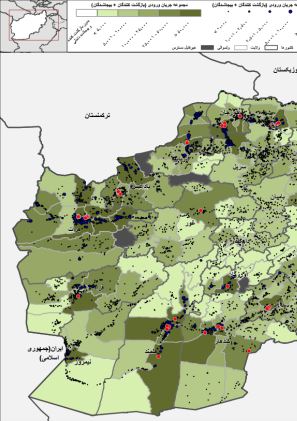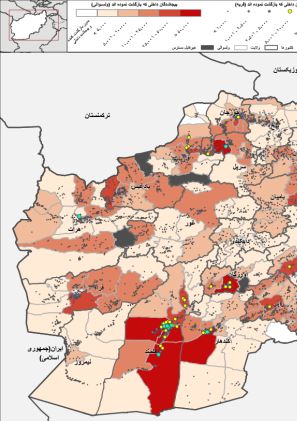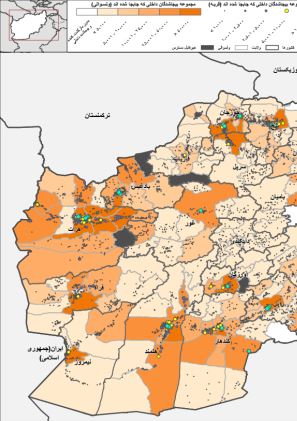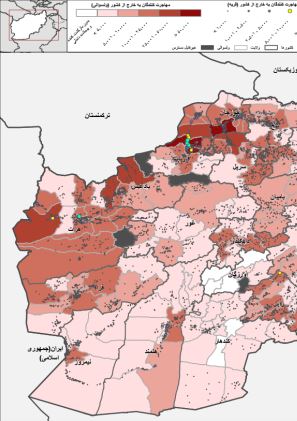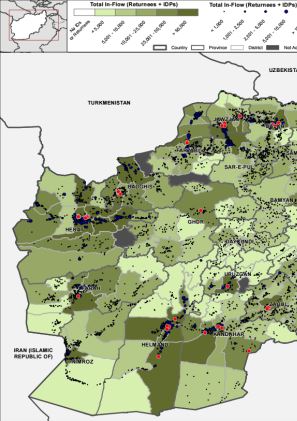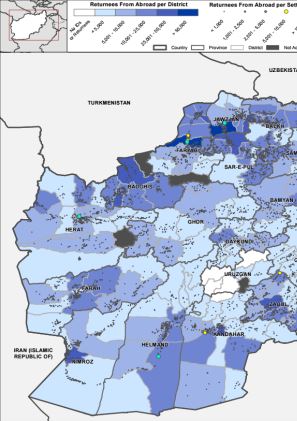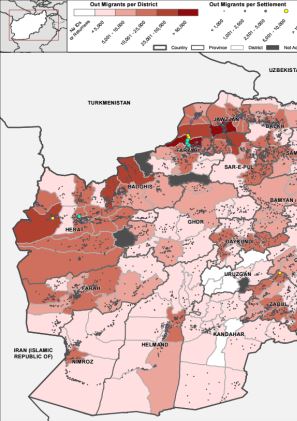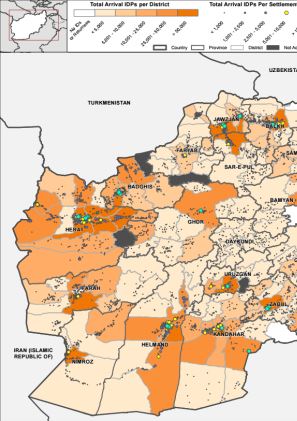-
Countries
-
Data and Analysis
-
Special Focus
-
Crisis Responses
Asia and the Pacific
DTM Asia and the Pacific
DTM Operations in the region
- Active DTM operation
- Past DTM operation
Papua New Guinea — Rapid Assessment Report Enga Province — Round 2 (27 July 2024)
On 24 May 2024, a massive landslide engulfed villages in Yambali Ward, Maip Mulitaka Local Level Government of Lagaip-Porgera District, Enga Province of Papua New Guinea. The landslide caused extensive damage to many lives, homes and livelihoods.
افغانستان - راپور مختصر جریان عبور و مرور (۱۴ - ۲۰ جولای ۲۰۲۴) [DARI]
فعالیت نظارت بر جریان عبور و مرور برنامه سیستم ردیابی بیجاشدگان (دی تی اِم) سازمان بین المللی مهاجرت افغانستان برای این دیزاین شده تا درک و فهم بهتر از تحرکات و تغییرات عبور و مرور در مرزهای افغانستان را بدست آورد.
افغانستان - د خلکو د تګ راتګ په اړه لنډ راپور (۱۴ - ۲۰ جولای ۲۰۲۴) [PASHTO]
د افغانستان آي اُو اِم د (ډي تي اِم) پروګرام د خلکو د تګ راتګ د جریان څارنې فعالیت د لپاره ډیزاین شوي ترڅو د ایران اسلامی جمهوریت او پاکستان سره په سرحدی پولو کې په سرحدونو کې د خوځښت او تګ راتګ په اړه ښه پوه شي.
Afghanistan - Flow Monitoring Snapshot (14-20 July 2024) [ENG]
The IOM Afghanistan’s DTM Flow Monitoring activity is designed to provide insights into the mobility patterns at Afghanistan’s border points with the Islamic Republic of Iran and Pakistan.
Pakistan – Afghan Response Community Needs Identification (CNI) | Round 1 | August – September 2023
The International Organization for Migration’s (IOM) CNI is used to provide a baseline on living conditions and needs of Afghan nationals in identified settlements rather than providing a detailed overview of multisectoral needs.
ประเทศไทย - การประเมินความต้องการหลายภาคส่วน พ.ศ. 2566 - จังหวัดเชียงใหม่ (Chiang Mai province)
บทสรุป: สรุปข้อมูลสำคัญนี้มีจุดมุ่งหมายเพื่อนำเสนอภาพรวมของสภาวการณ์ ความต้องการ และความท้าทายตามประเด็นหัวข้อต่าง ๆ ในหมู่ผู้ย้ายถิ่นชาวเมียนมาในจังหวัดเชียงใหม่ที่ไอโอเอ็ม ประเทศไทยได้ดำเนินการประเมินความต้องการหลายภาคส่วนระหว่างเดือนตุลาคม พ.ศ. 2566 ถึงมกราคม พ.ศ. 2567 เพื่
افغانستان - راپور مختصر جریان عبور و مرور (۷ - ۱۳ جولای ۲۰۲۴) [DARI]
فعالیت نظارت بر جریان عبور و مرور برنامه سیستم ردیابی بیجاشدگان (دی تی اِم) سازمان بین المللی مهاجرت افغانستان برای این دیزاین شده تا درک و فهم بهتر از تحرکات و تغییرات عبور و مرور در مرزهای افغانستان را بدست آورد.
افغانستان - د خلکو د تګ راتګ په اړه لنډ راپور (۷ - ۱۳ جولای ۲۰۲۴) [PASHTO]
د افغانستان آي اُو اِم د (ډي تي اِم) پروګرام د خلکو د تګ راتګ د جریان څارنې فعالیت د لپاره ډیزاین شوي ترڅو د ایران اسلامی جمهوریت او پاکستان سره په سرحدی پولو کې په سرحدونو کې د خوځښت او تګ راتګ په اړه ښه پوه شي.
Afghanistan - Flow Monitoring Snapshot (7-13 July 2024) [ENG]
The IOM Afghanistan’s DTM Flow Monitoring activity is designed to provide insights into the mobility patterns at Afghanistan’s border points with the Islamic Republic of Iran and Pakistan.
Afghanistan - Flow Monitoring Quarterly Report 2 (April - June 2024) [ENG]
Frequent movement at the borders with the Islamic Republic of Iran and Pakistan have been influenced by a variety of factors over the past few decades.
افغانستان - د خلکو د تګ راتګ په اړه لنډ راپور (۳۰ جون - ۶ جولای ۲۰۲۴) [PASHTO]
د افغانستان آي اُو اِم د (ډي تي اِم) پروګرام د خلکو د تګ راتګ د جریان څارنې فعالیت د لپاره ډیزاین شوي ترڅو د ایران اسلامی جمهوریت او پاکستان سره په سرحدی پولو کې په سرحدونو کې د خوځښت او تګ راتګ په اړه ښه پوه شي.
Afghanistan - Flow Monitoring Snapshot (30 June - 6 July 2024) [ENG]
The IOM Afghanistan’s DTM Flow Monitoring activity is designed to provide insights into the mobility patterns at Afghanistan’s border points with the Islamic Republic of Iran and Pakistan.
افغانستان - راپور مختصر جریان عبور و مرور (۳۰ جون - ۶ جولای۲۰۲۴) [DARI]
فعالیت نظارت بر جریان عبور و مرور برنامه سیستم ردیابی بیجاشدگان (دی تی اِم) سازمان بین المللی مهاجرت افغانستان برای این دیزاین شده تا درک و فهم بهتر از تحرکات و تغییرات عبور و مرور در مرزهای افغانستان را بدست آورد.
Pakistan — Flow Monitoring of Afghan Returnees — Bi-Weekly Report (16 – 30 June 2024)
The International Organization for Migration (IOM) in Pakistan collects data on the outflows of Afghans at the Torkham (Khyber Pakhtunkhwa), Badini, Bahramcha and Chaman (Balochistan) border crossing points (BCPs) to better understand the movements of Afghans returning
Pakistan – 2024 Rainfall | Flash Update #2 | 1 April – 31 May | Khyber Pakhtunkhwa
Rainfall in Khyber Pakhtunkhwa has impacted 8 districts, resulting in widespread damage and disruption. The highest volume of rainfall was recorded in Lakki Marwat district, leading to damages to houses, landslides, flash flooding, lightning strikes,
افغانستان - د خلکو د تګ راتګ په اړه لنډ راپور (۲۳ - ۲۹ جون۲۰۲۴) [PASHTO]
د افغانستان آي اُو اِم د (ډي تي اِم) پروګرام د خلکو د تګ راتګ د جریان څارنې فعالیت د لپاره ډیزاین شوي ترڅو د ایران اسلامی جمهوریت او پاکستان سره په سرحدی پولو کې په سرحدونو کې د خوځښت او تګ راتګ په اړه ښه پوه شي.
Afghanistan - Flow Monitoring Snapshot (23 - 29 June 2024) [ENG]
The IOM Afghanistan’s DTM Flow Monitoring activity is designed to provide insights into the mobility patterns at Afghanistan’s border points with the Islamic Republic of Iran and Pakistan.
افغانستان - راپور مختصر جریان عبور و مرور (۲۳ - ۲۹ جون ۲۰۲۴) [DARI]
فعالیت نظارت بر جریان عبور و مرور برنامه سیستم ردیابی بیجاشدگان (دی تی اِم) سازمان بین المللی مهاجرت افغانستان برای این دیزاین شده تا درک و فهم بهتر از تحرکات و تغییرات عبور و مرور در مرزهای افغانستان را بدست آورد.
افغانستان - د خلکو د تګ راتګ په اړه لنډ راپور (۱۶ - ۲۲ جون ۲۰۲۴) [PASHTO]
د افغانستان آي اُو اِم د (ډي تي اِم) پروګرام د خلکو د تګ راتګ د جریان څارنې فعالیت د لپاره ډیزاین شوي ترڅو د ایران اسلامی جمهوریت او پاکستان سره په سرحدی پولو کې په سرحدونو کې د خوځښت او تګ راتګ په اړه ښه پوه شي.
Afghanistan - Flow Monitoring Snapshot (16 - 22 June 2024) [ENG]
The IOM Afghanistan’s DTM Flow Monitoring activity is designed to provide insights into the mobility patterns at Afghanistan’s border points with the Islamic Republic of Iran and Pakistan.
Pakistan — Flow Monitoring of Afghan Returnees — Bi-Weekly Report (1 – 15 June 2024)
The International Organization for Migration (IOM) in Pakistan collects data on the outflows of Afghans at the Torkham (Khyber Pakhtunkhwa), Badini, Bahramcha and Chaman (Balochistan) border crossing points (BCPs) to better understand the movements of Afghans returning to Afghanistan.
افغانستان - راپور مختصر جریان عبور و مرور (۱۶ - ۲۲ جون۲۰۲۴) [DARI]
فعالیت نظارت بر جریان عبور و مرور برنامه سیستم ردیابی بیجاشدگان (دی تی اِم) سازمان بین المللی مهاجرت افغانستان برای این دیزاین شده تا درک و فهم بهتر از تحرکات و تغییرات عبور و مرور در مرزهای افغانستان را بدست آورد.
ชื่อรายงาน: ประเทศไทย - การประเมินความต้องการหลายภาคส่วน พ.ศ. 2566 - เขตกรุงเทพฯ และปริมณฑล (Greater Bangkok Area)
บทสรุป: สรุปข้อมูลสำคัญนี้มีจุดมุ่งหมายเพื่อนำเสนอภาพรวมของสภาวการณ์ ความต้องการ และความท้าทายตามประเด็นหัวข้อต่าง ๆ ในหมู่ผู้ย้ายถิ่นชาวเมียนมาในเขตกรุงเทพฯ และปริมณฑล ที่ไอโอเอ็ม ประเทศไทยได้ดำเนินการรวบรวมข้อมูลโดยการประเมินความต้องการหลายภาคส่วนของไอโอเอ็มระหว่างเดือนมิถุนายนถึงสิงหาคม พ.ศ.
افغانستان - د خلکو د تګ راتګ په اړه لنډ راپور (۹ - ۱۵ جون ۲۰۲۴) [PASHTO]
د افغانستان آي اُو اِم د (ډي تي اِم) پروګرام د خلکو د تګ راتګ د جریان څارنې فعالیت د لپاره ډیزاین شوي ترڅو د ایران اسلامی جمهوریت او پاکستان سره په سرحدی پولو کې په سرحدونو کې د خوځښت او تګ راتګ په اړه ښه پوه شي.
Pagination
Afghanistan - Baseline Assessment Settlement Round 7
Jan 17 2019
A baseline assessment is a sub-component of mobility tracking. It aims to collect data on IDP, migrant or returnee population presence in a defined administrative area of the country. This dataset contains information by settlement. Settlement is the lowest unit of observation used in Afghanistan
Afghanistan - Baseline Assessment District Round 7
Jan 17 2019
A baseline assessment is a sub-component of mobility tracking. It aims to collect data on IDP, migrant or returnee population presence in a defined administrative area of the country. This dataset presents a summary at the district level of data collected by DTM in Afghanistan.
Central Sulawesi Earthquake — Site Assessment Round 2
Dec 30 2018
A site assessment is a sub-component of mobility tracking. It aims to collect data on population presence, living conditions and needs in a particular displacement site or community.
Central Sulawesi Earthquake — Site Assessment Round 1
Nov 30 2018
A site assessment is a sub-component of mobility tracking. It aims to collect data on population presence, living conditions and needs in a particular displacement site or community.
Afghanistan - Baseline Assessment Settlement Round 6
Dec 27 2018
A baseline assessment is a sub-component of mobility tracking. It aims to collect data on IDP, migrant or returnee population presence in a defined administrative area of the country. This dataset contains information by settlement. Settlement is the lowest unit of observation used in Afghanistan
Afghanistan - Baseline Assessment District Round 6
Dec 27 2018
A baseline assessment is a sub-component of mobility tracking. It aims to collect data on IDP, migrant or returnee population presence in a defined administrative area of the country. This dataset presents a summary at the district level of data collected by DTM in Afghanistan.
DTM Vanuatu Round 3
Dec 13 2018
Population of Ambae according to the 2016 Mini-Census was 11,670. DTM is currently tracking a total of 11,380 displaced Ambaeans in 2,717 households across Sanma, Penama and Shefa provinces , which accounts for 97.5% of the 2016 population. At the request of NDMO, between 8th and 19th of…
Papua New Guinea - Site Assessment - Earthquake 2018 - Round 3
May 30 2018
A site assessment is a sub-component of mobility tracking. It aims to collect data on population presence, living conditions and needs in a particular displacement site or community.
Papua New Guinea - Site Assessment - Earthquake 2018 - Round 2
Apr 30 2018
A site assessment is a sub-component of mobility tracking. It aims to collect data on population presence, living conditions and needs in a particular displacement site or community.
Site Assessment - Lombok Earthquake Round 2
Oct 30 2018
A site assessment is a sub-component of mobility tracking. It aims to collect data on population presence, living conditions and needs in a particular displacement site or community.
Pakistan - Site Assessment - Round 6
Feb 29 2012
<p>13,325 IDP individuals and 2,533 IDP households were identified in Round 6.</p>
Pakistan - Site Assessment - Round 5
Jan 31 2012
<p>55,953 IDP individuals and 10,379 IDP households were identified in Round 5.</p>
Pakistan - Site Assessment - Round 4
Dec 30 2011
<p>225,472 IDP individuals and 42,447 IDP households were identified in Round 4.</p>
Pakistan - Site Assessment - Round 3
Nov 30 2011
<p>454,476 IDP individuals and 86,647 IDP households were identified in Round 3.</p>
Site Assessment - Lombok Earthquake Round 1
Oct 09 2018
A site assessment is a sub-component of mobility tracking. It aims to collect data on population presence, living conditions and needs in a particular displacement site or community.
Afghanistan - Baseline Assessment Settlement Round 5
Sep 26 2018
A baseline assessment is a sub-component of mobility tracking. It aims to collect data on IDP, migrant or returnee population presence in a defined administrative area of the country. This dataset contains information by settlement. Settlement is the lowest unit of observation used in Afghanistan
Afghanistan - Baseline Assessment District Round 5
Sep 26 2018
A baseline assessment is a sub-component of mobility tracking. It aims to collect data on IDP, migrant or returnee population presence in a defined administrative area of the country. This dataset presents a summary at the district level of data collected by DTM in Afghanistan.
Sri Lanka - Baseline Assessment Round 1
Jul 31 2017
A baseline assessment is a sub-component of mobility tracking. It aims to collect data on IDP, migrant or returnee population presence in a defined administrative area of the country.
Afghanistan - Baseline Assessment District Round 4
Mar 31 2018
A baseline assessment is a sub-component of mobility tracking. It aims to collect data on IDP, migrant or returnee population presence in a defined administrative area of the country. This dataset presents a summary at the district level of data collected by DTM in Afghanistan.
Afghanistan - Baseline Assessment Settlement 4
Mar 31 2018
A baseline assessment is a sub-component of mobility tracking. It aims to collect data on IDP, migrant or returnee population presence in a defined administrative area of the country. This dataset contains information by settlement. Settlement is the lowest unit of observation used in Afghanistan
Pagination
AFG_DTM_June2020_District_Total_Inflow_Overview_By_District&Villages (پشتو)
دا نقشه د ۲۰۱۲ کال څخه ۲۰۲۰ جون میاشتې اړوند ټولټال راغلیو کسانو په اړه ده (بهرنیو هېوادونو څخه راستنېدونکي + راغلي کورني بېځایه شوي).
AFG_DTM_June2020_District_Returnees_From_Abroad_Overview_By_District&Villages (پشتو)
دا نقشه د ۲۰۱۲ کال څخه ۲۰۲۰ جون میاشتې پورې اړوند بهرنیو هیوادونو څخه راستنېدونکو په اړه ده (هغه افغانان چې د ۶ میاشتو لپاره هېواد څخه بهر ته کډوال شوي ول او اوس بېرته افغانستان ته راستانه شوي دي).
AFG_DTM_June2020_District_Returned_IDPs_Overview_By_District&Villages (پشتو)
دا نقشه د ۲۰۱۲ کال څخه ۲۰۲۰ جون میاشتې دورې اړوند د پخوانیو کورنیو بېځایه شویو په اړه ده چې خپلو کورونو ته ستانه شوي (هغه افغانان چې له ارزول شویو کلیو څخه دي چې پخوا د کورنیو بېځایه شویو په توګه یې خپلې اصلي سیمې پرېښي وي خو اوس بېرته خپلو کورونو ته ستانه شوي).
AFG_DTM_June2020_District_Out_Migrants_Overview_By_District&Villages (پشتو)
دا نقشه د ۲۰۱۲ کال څخه ۲۰۲۰ جون میاشتې اړوند د هېواد څخه بهر ته کډوال شویو کسانو په اړه ده (هغه افغانان چې هېواد څخه بهر ته کډوال شوي).
AFG_DTM_June2020_District_Arrival_IDPs_Overview_By_District&Villages (پشتو)
دا نقشه د ۲۰۱۲ کال څخه ۲۰۲۰ جون میاشتې اړوند کوربه ټولنو ته راغلیو کورني بېځایه شویو کسانو په اړه ده (کورني بېځایه شوي چې له نورو ځایونو څخه یو له ارزول شویو کلیو کې اوسېږي).
AFG_DTM_June2020_District_Fled_IDPs_Overview_By_District&Villages (پشتو)
دا نقشه د ۲۰۱۲ کال څخه ۲۰۲۰ جون میاشتې اړوند د هغو کورني بېځایه شویو کسانو په اړه ده چې خپلې اصلي سیمې یې پریښي (هغه افغانان چې له ارزول شویو کلیو څخه د کورنیو بېځایه شویو په توګه یې خپلې سیمې پرېښي او د افغانستان دننه نورو ځایونو کې اوسېږي).
AFG_DTM_June2020_District_Total_Inflow_Overview_By_District&Villages (دری)
این نقشه مربوط دوره سال ۲۰۱۲ الی جون ۲۰۲۰ است و در مورد مجموعه جریان ورودی است (بازگشت کنندگان خارج از کشور + بیجاشدگان داخلی که جابجا شده اند).
AFG_DTM_June2020_District_Returnees_From_Abroad_Overview_By_District&Villages (دری)
این نقشه مربوط دوره سال ۲۰۱۲ الی جون ۲۰۲۰ است و در مورد کسانی از کشور های خارجی بازگشت نموده اند (افغان هایکه به حد اقل مدت ۶ ماه خارج از کشور بودند و حال دوباره به وطن بازگشت نموده اند).
AFG_DTM_June2020_District_Returned_IDPs_Overview_By_District&Villages(دری)
این نقشه مربوط دوره سال ۲۰۱۲ الی جون ۲۰۲۰ است و در مورد بیجاشدگان داخلی قبلی است که دوباره به محل اصلی خود بازگشت نموده اند (افغان هایکه از قریجات ارزیابی شده هستند و قبلاً محل اصلی خود را منحیث بیجاشدگان داخلی ترک نموده بودند و حال دوباره به خانه هایشان بازگشت نموده اند).
AFG_DTM_June2020_District_Arrival_IDPs_Overview_By_District&Villages_(دری)
این نقشه مربوط دوره سال ۲۰۱۲ الی جون ۲۰۲۰ است که در مورد بیجاشدگان داخلی که جابجا شده اند میباشد (بیجاشدگان داخلی از موقعیت های دیگر که فعلاً در یکی از قریجات ارزیابی شده به سر میبرند).
AFG_DTM_June2020_District_Out_Migrants_Overview_By_District&Villages(دری)
این نقشه مربوط دوره سال ۲۰۱۲ الی جون ۲۰۲۰ است و در مورد کسانی است که به خارج از کشور مهاجرت نموده اند (افغان هایکه به خارج از کشور نقل مکان نموده اند).
AFG_DTM_June2020_District_Fled_IDPs_Overview_By_District&Villages (دری)
این نقشه مربوط دوره سال ۲۰۱۲ الی جون ۲۰۲۰ است که در مورد بیجاشدگان داخلی که محل اصلی خود را ترک نموده اند میباشد (افغان هایکه از یکی از موقعیت های ارزیابی شده به محل دیگری در داخل افغانستان بیجا شده اند).
AFG_DTM_June2020_District_Total_Inflow_Overview_By_District&Villages
This map provides information on Total inflow (Returnees from Abroad + Arrival IDPs) during period of 2012 till June 2020.
AFG_DTM_June2020_District_Returnees_From_Abroad_Overview_By_District&Villages
This map provides information on Returnees from Abroad (Afghans who had fled abroad for at least 6 months and have now returned to Afghanistan) During period of 2012 till June 2020.
AFG_DTM_June2020_District_Returned_IDPs_Overview_By_District&Villages
This map provides information on Returned IDPs (Afghans from an assessed village who had fled as IDPs in the past and have now returned home) During period of 2012 till June 2020.
AFG_DTM_June2020_District_OutFlow_To_Europe_Overview_By_District&Villages
This map provides information on Outflow to Europe (Afghans who moved to non-neighboring countries) during period of 2012 till June 2020.
AFG_DTM_June2020_District_Out_Migrants_Overview_By_District&Villages
This map provides information on Out Migrants (Afghans who moved or fled abroad) During period of 2012 till June 2020.
AFG_DTM_June2020_District_Arrival_IDPs_Overview_By_District&Villages
This map provides information on Arrival IDPs (IDPs from other location currently residing in an assessed village) during period of 2012 till June 2020.
AFG_DTM_June2020_District_Fled_IDPs_Overview_By_District&Villages
This map provides information on Fled IDPs (Afghans from an assessed village who fled as IDPs to reside elsewhere in Afghanistan) During period of 2012 till June 2020.
DTM COVID-19 Regional Atlas Point Operational Status As Of 15 October 2020
The current outbreak of COVID-19 has affected global mobility in complex and unprecedented ways in the form of various travel restrictions, suspension of air travel, and border closures. To better understand this, the International Organization for Migration (IOM) has developed a global mobility database to map these impacts on human mobility, across global, regional, and country levels. Furthermore, COVID-19 has had a disproportionate impact on vulnerable populations in camps and camp-like settings as well as exacerbated the vulnerabilities of mobile populations who may now be stranded owing to COVID-19 related mobility restrictions. This data is particularly important when addressing specific needs faced by migrants and mobile populations.IOM has developed a global mobility database mapping the status of different Points of Entry (PoE) and Key Locations of Internal Mobility, globally. These include airports, land border crossing points (could be rail or road), blue border crossing points (sea, river or lake), internal transit points, and areas of interest. For each point of entry, data is collected on the type of restriction, measured applied, and the timeframe, as well as the population category that may be affected by the restrictive measures. This workstream uses direct input from IOM missions and this dashboard displays regularly updated mobility restrictions at the location level.
DTM COVID-19 Regional Atlas Point Operational Status As Of 01 October 2020
The current outbreak of COVID-19 has affected global mobility in complex and unprecedented ways in the form of various travel restrictions, suspension of air travel, and border closures. To better understand this, the International Organization for Migration (IOM) has developed a global mobility database to map these impacts on human mobility, across global, regional, and country levels. Furthermore, COVID-19 has had a disproportionate impact on vulnerable populations in camps and camp-like settings as well as exacerbated the vulnerabilities of mobile populations who may now be stranded owing to COVID-19 related mobility restrictions. This data is particularly important when addressing specific needs faced by migrants and mobile populations.IOM has developed a global mobility database mapping the status of different Points of Entry (PoE) and Key Locations of Internal Mobility, globally. These include airports, land border crossing points (could be rail or road), blue border crossing points (sea, river or lake), internal transit points, and areas of interest. For each point of entry, data is collected on the type of restriction, measured applied, and the timeframe, as well as the population category that may be affected by the restrictive measures. This workstream uses direct input from IOM missions and this dashboard displays regularly updated mobility restrictions at the location level.
DTM COVID-19 Regional Atlas Point Operational Status As Of 28 August 2020
The current outbreak of COVID-19 has affected global mobility in complex and unprecedented ways in the form of various travel restrictions, suspension of air travel, and border closures. To better understand this, the International Organization for Migration (IOM) has developed a global mobility database to map these impacts on human mobility, across global, regional, and country levels. Furthermore, COVID-19 has had a disproportionate impact on vulnerable populations in camps and camp-like settings as well as exacerbated the vulnerabilities of mobile populations who may now be stranded owing to COVID-19 related mobility restrictions. This data is particularly important when addressing specific needs faced by migrants and mobile populations.IOM has developed a global mobility database mapping the status of different Points of Entry (PoE) and Key Locations of Internal Mobility, globally. These include airports, land border crossing points (could be rail or road), blue border crossing points (sea, river or lake), internal transit points, and areas of interest. For each point of entry, data is collected on the type of restriction, measured applied, and the timeframe, as well as the population category that may be affected by the restrictive measures. This workstream uses direct input from IOM missions and this dashboard displays regularly updated mobility restrictions at the location level.
DTM COVID-19 Regional Atlas Point Operational Status As Of 20 August 2020
The current outbreak of COVID-19 has affected global mobility in complex and unprecedented ways in the form of various travel restrictions, suspension of air travel, and border closures. To better understand this, the International Organization for Migration (IOM) has developed a global mobility database to map these impacts on human mobility, across global, regional, and country levels. Furthermore, COVID-19 has had a disproportionate impact on vulnerable populations in camps and camp-like settings as well as exacerbated the vulnerabilities of mobile populations who may now be stranded owing to COVID-19 related mobility restrictions. This data is particularly important when addressing specific needs faced by migrants and mobile populations.IOM has developed a global mobility database mapping the status of different Points of Entry (PoE) and Key Locations of Internal Mobility, globally. These include airports, land border crossing points (could be rail or road), blue border crossing points (sea, river or lake), internal transit points, and areas of interest. For each point of entry, data is collected on the type of restriction, measured applied, and the timeframe, as well as the population category that may be affected by the restrictive measures. This workstream uses direct input from IOM missions and this dashboard displays regularly updated mobility restrictions at the location level.
DTM COVID19 Regional Atlas Point Operational Status As Of 6 August 2020
The current outbreak of COVID-19 has affected global mobility in complex and unprecedented ways in the form of various travel restrictions, suspension of air travel, and border closures. To better understand this, the International Organization for Migration (IOM) has developed a global mobility database to map these impacts on human mobility, across global, regional, and country levels. Furthermore, COVID-19 has had a disproportionate impact on vulnerable populations in camps and camp-like settings as well as exacerbated the vulnerabilities of mobile populations who may now be stranded owing to COVID-19 related mobility restrictions. This data is particularly important when addressing specific needs faced by migrants and mobile populations.IOM has developed a global mobility database mapping the status of different Points of Entry (PoE) and Key Locations of Internal Mobility, globally. These include airports, land border crossing points (could be rail or road), blue border crossing points (sea, river or lake), internal transit points, and areas of interest. For each point of entry, data is collected on the type of restriction, measured applied, and the timeframe, as well as the population category that may be affected by the restrictive measures. This workstream uses direct input from IOM missions and this dashboard displays regularly updated mobility restrictions at the location level.





















